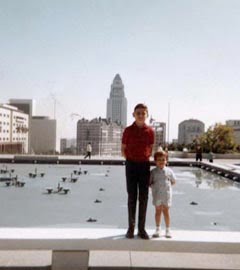
Echo Park Lake - from a family photo album - July 1910

Echo Park Picnic - from a family photo album - July 4, 1910 or 1913
Echo Park Kodachrome slide - from Madge Donohue's photo album - 1959

My friend Madge in front of her Clinton St. house, Kodachrome slide - 1959

Echo Park Lake, digital snapshot from condo across the street - 2010
On a muggy day in July of 1910 friends and family gather at the Echo Park Lake in the city of Los Angeles for an afternoon of conversation, food and celebration. Among the lotus leaves, a three legged dog swims after a stick, propelled into the lake by his owner and just as quickly, returned to him for another go around. Two old men engage in a game of checkers on an old wooden board which is hand colored with black and red squares. They pass a flask back and forth and ponder each other’s next move on the homemade checkerboard. One is an out of work carpenter that will soon be working at the Mack Sennett Studios and the other is a drifter from Muncie, Indiana. On the other side of the lake, a group of girls gather under a palm tree and softly whisper to each other about a young man that is riding his bicycle around the lake. He is but 23 years of age, with a slim build and is wearing a straw hat and the only coat he owns, a wool button-down that is much more suited for the winters of Iowa where he has recently arrived from. The whispers quickly turn to giggles as his straw hat escapes him and blows into the lake where it floats away to the center of the water and away from reach. Off in the distance the humming of the oil derricks that are rich in Echo Park can be heard, as a lone Victorian home barely in its teenage years sits atop of the hill overlooking the festivities of the day. A loud bell is rung by the matriarch of the family that has gathered at the lake this afternoon signaling that food is being served. As two dozen friends and family members make their way to the picnic area, the drifter from Indiana abruptly ends his game of checkers and roams to the site of the picnic where he politely asks to be fed, his breath smells of rye.
It's July 1910 in Echo Park and a few years later the sounds of heavy construction will dominate the neighborhood as Aimee Semple McPherson’s Angelus Temple begins to take shape across the street from the lake on Glendale Blvd. In the mid century decade, the West Coast sounds of Art Pepper’s alto saxophone could be heard in the late evening hours as he plays his horn on the porch of his Echo Park craftsman residence. About the same time, my friend Madge Donohue arrives from Oswego, Kansas and moves into a house on Clinton Street overlooking the lake where she lives alone until her death in 2004. In the early 1990s, the sights and sounds of a film crew fill the conversations at the Pioneer Market located at the intersection of Echo Park Blvd and Sunset Blvd as Allison Anders’ “Mi Vida Loca” is being filmed in the neighborhood. Today, young bohemians transplanted from all over the country line up around the block to hear live music at the popular EchoPlex music venue on Glendale Blvd. It's mid July and the summer heat has arrived.

















